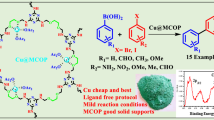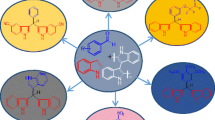Abstract
One pot, solvent free ring opening polymerization (ROP) of propylene oxide (PO) was studied by using lab synthesized heterogeneous double metal cyanide (DMC) catalyst. A series of DMC catalysts was prepared by using EDTA as novel complexing agent (CA) and characterized in detail by PXRD, FT-IR, UV–Vis, 13C CP-MAS NMR, AAS, SEM, XPS, and CHNS analyzer. The suitable amount of CA favored high Zn/Fe ratio and enhanced catalytic activity for polyoxypropylene glycol (PPG) synthesis. It was observed that the properties of PPG are governed by reaction parameters, including catalyst amount, reaction time, temperature, pressure, feed to initiator ratio, and different initiators. The prepared polymers have Mw (160 to 19,667 g mol−1) and PDI (1.05 to 3.01) during optimization. The structure elucidation of PPG was confirmed by FT-IR, GPC, and 1H NMR. Dipropylene glycol (DPG) initiator yielded highest 93% PPG with 1.29 PDI, and 4.9 mg-KOH g−1 hydroxyl value. The kinetics study confirms first-order reaction with proposed coordination mechanism.








Similar content being viewed by others
References
O'Connor JM, Lickei DL, Grieve RL (2002) US Patent 6,359,101
Patton J (1976) Chem Tech 6:780
Becker H, Wagner G (1984) Zur Übertragungsreaktion bei der anionichen Polymerisation von Oxiranen VI. Zum Einfluß von Kronenetherzusätzen auf die Polymerisation von Propylenoxid†. Acta Polym 35:28–32
Wu B, Harlan CJ, Lenz RW, Barron AR (1997) Macromolecules 30:316–318
Emig N, Ngugen H, Krautscheid H, Eau R, Cazaux JB, Bertrand G (1998) Organometllics 17:3599–3608
Marbach J, Nörnberg B, Rahlf A, Luinstra G (2017) Zinc glutarate-mediated copolymerization of CO 2 and PO–parameter studies using design of experiments. Catal Sci Technol 7:2897–2905
van der Hulst H, Pogany G.A., Kuyper J (1984) US Patent 4,477,589
Yu GE, Masters AJ, Heatley F, Booth C, Blease TG (1994) Anionic polymerisation of propylene oxide. Investigation of double-bond and head-to-head content by NMR spectroscopy. Macromole Chem Phys 195:1517–1538
Exner JH, Steiner EC (1974) Solvation and ion pairing of alkali-metal alkoxides in dimethyl sulfoxide. Conductometric studies. J Am Chem SOC 96:1782–1787
Herold R, Livigni R (1972) Polymerization of cyclic ethers and sulfides. Polym Prepr 13:545–551
Herold R (1974) Amorphous, high molecular weight polypropylene oxide, macromolecular. Synthesis 5:9–13
Le-Khac B (1998) Highly active double metal cyanide catalysts, US Patent 5,693,584
Le-Khac B (1995) Double metal cyanide complex catalysts, US Patent 5,470,813
van der Hulst H, Pogany GA, Kuyper J (1984) Catalysts for the polymerization of epoxides and process for the preparation of such catalysts, US Patent 4,477,589
TH, Watabe T, Doi T, Kunii N (1990) Eur Pat Appl EP 383,333
TH, Yamada K (1992) JP 4,415,123
Kim I, Ahna J-T, Haa CS, Yangb CS, Park I (2003) Polymerization of propylene oxide by using double metal cyanide catalysts and the application to polyurethane elastomer. Polymer 44:3417–3428
Sebastian J, Srinivas D (2014) Effects of method of preparation on catalytic activity of Co–Zn double-metal cyanide catalysts for copolymerization of CO2 and epoxide. Appl Catal A 482:300–308
Kim I, Yi MJ, Lee KJ, Park D-W, Kim BU, Ha C-S (2006) Aliphatic polycarbonate synthesis by copolymerization of carbon dioxide with epoxides over double metal cyanide catalysts prepared by using ZnX2 (X= F, Cl, Br, I). Catal Today 111:292–296
Dienes Y, Leitner W, Müller MG, Offermans WK, Reier T, Reinholdt A, Weirich TE, Müller TE (2012) Hybrid sol–gel double metal cyanide catalysts for the copolymerisation of styrene oxide and CO 2. Green Chem 14:1168–1177
Varghese JK, Park DS, Jeon JY, Lee BY (2013) Double metal cyanide catalyst prepared using H3Co (CN) 6 for high carbonate fraction and molecular weight control in carbon dioxide/propylene oxide copolymerization. J Polym Sci Part A Polym Chem 51:4811–4818
Srivastava R, Srinivas D, Ratnasamy P (2006) Fe–Zn double-metal cyanide complexes as novel, solid transesterification catalysts. J Catal 241:34–44
Srinivas D, Srivastava R, Ratnasamy P (2010) Transesterification catalyst and a process for the preparation thereof, US Patent 7754643B2
García-Ortiz A, Grirrane A, Reguera E, García H (2014) Mixed (Fe2+ and Cu2+) double metal hexacyanocobaltates as solid catalyst for the aerobic oxidation of oximes to carbonyl compounds. J Catal 311:386–392
Sebastian J, Srinivas D (2013) Influence of method of preparation of solid, double-metal cyanide complexes on their catalytic activity for synthesis of hyperbranched polymers. Appl Catal A 464:51–60
Yoon JH, Lee IK, Choi HY, Choi EJ, Yoon JH, Shimc SE, Kim II (2011) Double metal cyanide catalysts bearing lactate esters as eco-friendly complexing agents for the synthesis of highly pure polyols. Green Chem 13:631–639
ChenZhang SP, Chen L (2004) Fe/Zn double metal cyanide (DMC) catalyzed ring-opening polymerization of propylene oxide Part 3. Synthesis of DMC catalysts. Prog Org Coat 50:269–272
Dios MP, Andres-Iglesias C, Fernandez A, Salmi T, Galdamez JR, Garcia-Serna J (2017) Effect of Zn/Co initial preparation ratio in the activity of double metal cyanide catalysts for propylene oxide and CO2 copolymerization. Eur Polymer J 88:280–291
Tharun J, Dharman MM, Hwang Y, Roshan R, Park MS, Park D-W (2012) Tuning double metal cyanide catalysts with complexing agents for the selective production of cyclic carbonates over polycarbonates. Appl Catal A 419:178–184
Tran CH, Pham LTT, Lee Y, Jang HB, Kim S, Kim I (2019) Mechanistic insights on Zn (II)− Co (III) double metal cyanide-catalyzed ring-opening polymerization of epoxides. J Catal 372:86–102
Almora-Barrios N, Pogodin S, Bellarosa L, García-Melchor M, Revilla-López G, García-Ratés M, Vázquez-García AB, Hernández-Ariznavarreta P, López N (2015) Structure, activity, and deactivation mechanisms in double metal cyanide catalysts for the production of polyols. ChemCatChem 7:928–935
Huang YJ, Zhang XH, Hua ZJ, Chen SL, Qi GR (2010) Ring-opening polymerization of propylene oxide catalyzed by a calcium-chloride-modified zinc-cobalt double metal-cyanide complex. Macromol Chem Phys 211:1229–1237
Coates J (2000) Interpretation of infrared spectra, a practical approach, Citeseer
Chen S, Qi GR, Hua ZJ, Yan HQ (2004) Double metal cyanide complex based on Zn3 [Co (CN) 6] 2 as highly active catalyst for copolymerization of carbon dioxide and cyclohexene oxide. J Polym Sci Part A Polym Chem 42:5284–5291
Huang Y, Qi G, Feng L (2002) Preparation, characterization and catalytic performance of double metal-cyanide complexes. Chin J Catal 23:113–117
Peeters A, Valvekens P, Ameloot R, Sankar G, Kirschhock CE, De Vos DE (2013) Zn–Co double metal cyanides as heterogeneous catalysts for hydroamination: A structure–activity relationship. ACS Catal 3:597–607
Yi MJ, Byun S-H, Ha C-S, Park D-W, Kim I (2004) Copolymerization of cyclohexene oxide with carbon dioxide over nano-sized multi-metal cyanide catalysts. Solid State Ionics 172:139–144
Kim I, Ahn J-T, Ha CS, Yang CS, Park I (2003) Polymerization of propylene oxide by using double metal cyanide catalysts and the application to polyurethane elastomer. Polymer 44:3417–3428
Grosvenor A, Kobe B, Biesinger M, McIntyre N (2004) Investigation of multiplet splitting of Fe 2p XPS spectra and bonding in iron compounds. Surf Interface Anal Int J Devoted Dev Appl Tech Anal Surf Interfaces Thin Films 36:1564–1574
Aime S, Gobetto R, Nano R, Santucci E (1987) 13C solid state CP/MAS NMR studies of edta complexes. Inorg Chim Acta 129:L23–L25
Grobelny Z, Matlengiewicz M, Jurek-Suliga J, Golba S, Skrzeczyna K (2018) The influence of initiator and macrocyclic ligand on unsaturation and molar mass of poly (propylene oxide) s prepared with various anionic system. Polym Bull 75:1101–1121
Ma J-H, Guo C, Tang Y-L, Liu H-Z (2007) 1H NMR spectroscopic investigations on the micellization and gelation of PEO− PPO− PEO block copolymers in aqueous solutions. Langmuir 23:9596–9605
Schilling FC, Tonelli AE (1986) Carbon-13 NMR determination of poly (propylene oxide) microstructure. Macromolecules 19:1337–1343
Larkin P (2011) Infrared and Raman Spectroscopy, Principles and Spectral Interpretation, 1st edn. Elsevier, Oxford
Lligadas G, Ronda J, Galia M, Biermann U, Metzger J (2006) Synthesis and characterization of polyurethanes from epoxidized methyl oleate based polyether polyols as renewable resources. J Polym Sci Part A Polym Chem 44:634–645
Shin SR, Kim HN, Liang JY, Lee SH, Lee DS (2019) Sustainable rigid polyurethane foams based on recycled polyols from chemical recycling of waste polyurethane foams. J Appl Polym Sci 136:47916
Molero C, de Lucas A, Rodríguez JF (2006) Recovery of polyols from flexible polyurethane foam by “split-phase” glycolysis: Glycol influence. Polym Degrad Stab 91:221–228
Phan H, Kortsen K, Englezou G, Couturaud B, Nedoma AJ, Pearce AK, Taresco V (2020) Functional initiators for the ring-opening polymerization of polyesters and polycarbonates: An overview. J Polym Sci 58:1911–1923
Tran CH, Lee MW, Kim SA, Jang HB, Kim I (2020) Kinetic and mechanistic study of heterogeneous double metal cyanide-catalyzed ring-opening multibranching polymerization of glycidol. Macromolecules 53:2051–2060
Kang M, Liu X, Wang X (2002) Hecheng Xiangjiao Gongye 14:247
Zhou T, Zou Z, Gan J, Chen L, Zhang M (2011) Copolymerization of epoxides and carbon dioxide by using double metal cyanide complex (DMC) with high crystallinity. J Polym Res 18:2071–2076
Acknowledgements
The authors are grateful to Director, CSIR-IIP, for his kind permission to publish the results. UK is thankful to CSIR for research funding (OLP-1111). AV and VV acknowledge Department of Science and Technology (DST) for providing INSPIRE research fellowship. SS and BS are grateful to CSIR for the research fellowship. The authors are thankful to Analytical Science Division, CSIR-IIP, for their analytical support.
Author information
Authors and Affiliations
Corresponding author
Additional information
Publisher's Note
Springer Nature remains neutral with regard to jurisdictional claims in published maps and institutional affiliations.
Highlights
• Room temperature synthesized double metal cyanide (DMC) catalyst using EDTA as a novel complexing agent (CA).
• Prepared DMC catalyst is effective for PPG synthesis via ring-opening polymerization.
• CA imparts the heterogeneity in the DMC catalyst and recyclability.
• DMC catalyst has higher activity with >99% PPG yield, low PDI (1.05), and low hydroxyl number (4.9 mg-KOH g-1).
• A detailed study of structure reactivity and relationship for PPG synthesis using DMC catalyst.
• A first-order reaction kinetics for PPG synthesis.
Supplementary Information
Below is the link to the electronic supplementary material.
Rights and permissions
Springer Nature or its licensor (e.g. a society or other partner) holds exclusive rights to this article under a publishing agreement with the author(s) or other rightsholder(s); author self-archiving of the accepted manuscript version of this article is solely governed by the terms of such publishing agreement and applicable law.
About this article
Cite this article
Verma, A., Saini, S., Sharma, B. et al. EDTA incorporated Fe-Zn double metal cyanide catalyst for the controlled synthesis of polyoxypropylene glycol. J Polym Res 30, 62 (2023). https://doi.org/10.1007/s10965-022-03407-6
Received:
Accepted:
Published:
DOI: https://doi.org/10.1007/s10965-022-03407-6




